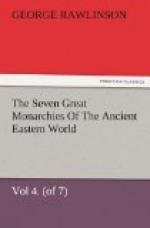In mixtures of this kind it is almost always found that some one element practically preponderates, and assumes to itself the right of fashioning and forming the general character of the race. It is not at all necessary that this formative element should be larger than any other; on the contrary, it may be and sometimes is extremely small; for it does not work by its mass, but by its innate force and strong vital energy. In Babylonia, the element which showed itself to possess this superior vitality, which practically asserted its pre-eminence and proceeded to mold the national character, was the Semitic. There is abundant evidence that by the time of the later Empire the Babylonians had become thoroughly Semitized; so much so, that ordinary observers scarcely distinguished them from their purely Semitic neighbors, the Assyrians. No doubt there were differences which a Hippocrates or an Aristotle could have detected—differences resulting from mixed descent, as well as differences arising from climate and physical geography; but, speaking broadly, it must be said that the Semitic element, introduced into Babylonia from the north, had so prevailed by the time of the establishment of the Empire that the race was no longer one sui generis, but was a mere variety of the well-known and widely spread Semitic type.
We possess but few notices, and fewer assured representations, from which to form an opinion of the physical characteristics of the Babylonians. Except upon the cylinders, there are extant only three or four representations of the human forms by Babylonian artists, and in the few cases where this form occurs we cannot always feel at all certain that the intention is to portray a human being. A few Assyrian bas-reliefs probably represent campaigns in Babylonia; but the Assyrians vary their human type so little that these sculptures must not be regarded as conveying to us very exact information. Tho cylinders are too rudely executed to be of much service, and they seem to preserve an archaic type which originated with the Proto-Chaldaeans. If we might trust the figures upon them as at all nearly representing the truth, we should have to regard the Babylonians as of much slighter and sparer frames than their northern neighbors, of a physique in fact approaching to meagreness. The Assyrian sculptures, however, are far from bearing out this idea; from them it would seem that the frames of the Babylonians were as brawny and massive as those of the Assyrians themselves, while in feature there was not much difference between the nations. [Plate IX., Fig. 3.] Foreheads straight but not high, noses well formed but somewhat depressed, full lips, and a well-marked rounded chin, constitute the physiognomy of the Babylonians as it appears upon the sculptures of their neighbors. This representation is not contradicted by the few specimens of actual sculpture left by themselves. In these the type approaches nearly to the Assyrian, while there is still, such an amount of difference as renders it tolerably easy to distinguish between the productions of the two nations. The eye is larger, and not so decidedly almond-shaped; the nose is shorter, and its depression is still more marked; while the general expression of the countenance is altogether more commonplace.




